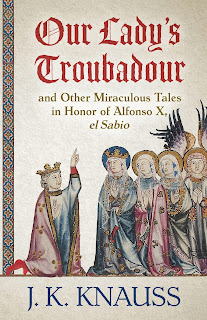 |
| María de Padilla and Pedro of Castile with María's coat of arms |
By J. K. Knauss
María de Padilla met King Pedro of Castile
during the summer of 1352, when she was eighteen years old, “intelligent,
beautiful, and small in size,” according to contemporary chronicles. The king,
who was also eighteen at the time, recognized in her a kindred spirit, and she
quickly became the love of his life. Although Pedro’s monarch status obliged
him to marry more politically advantageous women, María’s willingness to accept
his love outside the bonds of matrimony earned her an important place in
European history and the royal gene pool. Indeed, it’s difficult to take two
steps in Sevilla and in some parts of Castilla y León today without coming
across a monument dedicated to her, a room she lived in, or a monastery she
founded.
 |
| A salon in the King Pedro area of the Royal Palace in Sevilla Photo by J. K. Knauss |
King Pedro (r. 1350–1369) has not one but two
sobriquets recorded in the history books: the Cruel, or the Just. This reflects
the complex panorama of the time. He was loved or hated, but no one was
indifferent to his policies in a war with Aragón, or his stance regarding what
would become the Hundred Years War. These were the early days of sociopolitical
turmoil following the Black Death, which had already devastated the Iberian Peninsula
and would strike again during Pedro’s reign.
María came of noble lineage, and many of her
family members were appointed to high offices at court. It was probably
inevitable that she and the king would meet at some time, but it happened to
occur during a trip the king made to Asturias to deal with Enrique, his
half-brother who would eventually kill him and take the crown, beginning the
Trastámara dynasty.
 |
| The Salon of María de Padilla as it was furnished in 1892. Courtesy of pastpictures.org |
Many stories have circulated about the king
marrying María in secret soon after he met her, and later glossing over the
legally valid ceremony because of political pressures to marry Blanche of
Bourbon, first cousin of the King of France. The marriage failed spectacularly,
and a later one was also short-lived and lacking issue. María, on the other
hand, gave Pedro four children: Beatriz, who became a nun at Tordesillas;
Constanza, who married John of Gaunt because King Pedro’s loyalties really lay
with the English; Isabel, who married Edmund of Langley; and a son who didn’t
survive childhood.
Her unsanctioned relationship with Pedro caused
the historians of her time to overlook her accomplishments. While it’s possible
she stayed out of the political arena, it seems unlikely she never told the
king what she thought of any of the volatile issues of his reign. She is on
record as buying expensive properties and founding the convent of Santa Clara
de Astudillo. All of the buildings associated with her feature elegant mudéjar
and Gothic architecture.
 |
| The author pretends to be María de Padilla on a hot September day. |
María died at about 27 years of age in 1361,
possibly as a result of plague. Her body was buried in the convent she had
founded. But her remains were soon transferred to join other members of the
royal family in the royal chapel in the cathedral of Sevilla, where they still
rest today. This move could have been motivated by Pedro’s continued devotion, but it was
also strategic in gaining recognition of María’s son, Alfonso, as Pedro’s heir.
In any case, María de Padilla is remembered as Pedro’s queen, in the practical sense if not by
law.
 |
| The "Baths of María de Padilla" below the Gothic area of the Royal Palace in Sevilla are actually the rain catchment system. Photo by J. K. Knauss |
Although mostly unappreciated in her time, María’s
story has captivated novelists and artists ever since. A
nineteenth-century opera offers two emotional interpretations of her historical
status. In the first version, which was rejected by censors, María seizes the
crown from Blanche of Bourbon’s head and then commits suicide. In the final
version, Pedro proclaims María as his queen instead of Blanche, and María
perishes from the overwhelming joy of attaining what later critics believe must
have been her most fervent wish.
A
driven fiction writer, J. K. Knauss has edited many fine historical novels and
is a bilingual freelance editor. Her historical epic, Seven Noble Knights, will be released by Encircle Publications December 11, 2020. J. K. Knauss earned a PhD in medieval Spanish with a dissertation on the portrayal of Alfonso X’s laws in the Cantigas de Santa Maria, which has been published as the five-star-rated Law and Order in Medieval Spain. Look for her book based on the Cantigas, coming in 2021. On the
contemporary side, her YA/NA paranormal Awash in Talent was
published by Kindle Press. Find out more about her writing and bookish activities here. Follow her on Facebook and Twitter,
too!



















